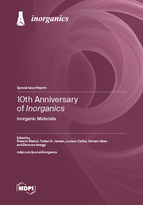10th Anniversary of Inorganics: Inorganic Materials
A special issue of Inorganics (ISSN 2304-6740). This special issue belongs to the section "Inorganic Materials".
Deadline for manuscript submissions: closed (31 October 2023) | Viewed by 34236
Special Issue Editors
Interests: biomaterials; catalysis; cement and concrete; ceramics; composites; coatings; copper; energy; iron oxides; magnetic materials; nanomaterials; photocatalysis; porous materials; sol-gel; surface functionalization; templating
Special Issues, Collections and Topics in MDPI journals
Interests: synthesis and characterization of inorganic materials; structural, chemical and physical properties; energy storage as hydrogen or electricity in novel types of batteries; multivalent solid state batteries
Special Issues, Collections and Topics in MDPI journals
Interests: nanomaterials; mesoporous materials; iron oxides; photochemistry; photocatalysis; advanced oxidation processes
Interests: catalysis; hydrogen production/water splitting; electron transfer; surface reactions; reducible oxides
Special Issues, Collections and Topics in MDPI journals
Interests: homogeneous catalysis; heterogeneous catalysis; metal-based catalyst; wastewater treatment; sustainability; catalytic oxidation
Special Issues, Collections and Topics in MDPI journals
Special Issue Information
Dear Colleagues,
To celebrate the 10th anniversary of our journal Inorganics and its first Impact Factor (Clerivate Analytics), the “Inorganic Materials” section has taken the initiative to launch a Special Issue entitled “10th Anniversary of Inorganics: Inorganic Materials”. The “Inorganic Materials” section in Inorganics is quite recent (i.e., the beginning of 2022). However, it has rapidly grown, with 27 open Special Issues contributing to 25% journal’s publications in almost 1 year of activity, thus becoming an important cornerstone of Inorganics. The reason for this positive result is the continuously growing demand for advanced functional inorganic materials for a large variety of technological fields and applications.
However, the recent and numerous public demonstrations in support of climate and ecological justice, and the recent energetic crisis have revealed the actual importance of technological sustainability. The “Inorganic Materials” section in Inorganics strongly supports a transition towards a 'green' and sustainable future based on renewable energy and with closed life cycles for all used material. Therefore, this Special Issue focuses on the sustainable production of inorganic materials following alternative ecofriendly methods. In particular, new protocols and strategies for the reuse of materials are important to be further developed, in order to save minerals and raw materials, and reduce the production of waste and pollution of the environment. The aim of this Special Issue is to increase the knowledge of the latest advances, highlight challenges, address unresolved issues, and evidence newly emerging areas of interest involving the sustainable use of inorganic materials. We hope to inspire and encourage further research efforts in this important area.
Therefore, it is with great pleasure that we are inviting colleagues and experts in the field to submit original articles, short communications, and critical reviews on this actual topic. The scope of this Special Issue is intentionally left broad in order to allow extending the discussion within the entire focus area where inorganic materials can play a key role in order to reach a sustainable future.
We look forward to receiving your contributions.
Dr. Roberto Nisticò
Prof. Dr. Torben R. Jensen
Dr. Luciano Carlos
Prof. Dr. Hicham Idriss
Dr. Eleonora Aneggi
Guest Editors
Manuscript Submission Information
Manuscripts should be submitted online at www.mdpi.com by registering and logging in to this website. Once you are registered, click here to go to the submission form. Manuscripts can be submitted until the deadline. All submissions that pass pre-check are peer-reviewed. Accepted papers will be published continuously in the journal (as soon as accepted) and will be listed together on the special issue website. Research articles, review articles as well as short communications are invited. For planned papers, a title and short abstract (about 100 words) can be sent to the Editorial Office for announcement on this website.
Submitted manuscripts should not have been published previously, nor be under consideration for publication elsewhere (except conference proceedings papers). All manuscripts are thoroughly refereed through a single-blind peer-review process. A guide for authors and other relevant information for submission of manuscripts is available on the Instructions for Authors page. Inorganics is an international peer-reviewed open access monthly journal published by MDPI.
Please visit the Instructions for Authors page before submitting a manuscript. The Article Processing Charge (APC) for publication in this open access journal is 2700 CHF (Swiss Francs). Submitted papers should be well formatted and use good English. Authors may use MDPI's English editing service prior to publication or during author revisions.
Keywords
- adsorption
- advanced (green) synthesis
- batteries
- bio-inspired materials
- catalysis
- carbon dioxide storage and conversion
- electrochemistry
- energy storage devices
- environmental remediation
- fuel cells
- hybrid materials
- hydrogen storage
- nano-composites
- nanomaterials
- photo(electro)catalysis
- photovoltaics
- renewable energy
- sensing
- smart materials
- stimuli-responsive materials
- surface modification
- sustainable materials and technologies
- technologies for (clean) energy production
- thin films
- water splitting
- energy and materials recovery from industrial waste
- energy production
- recycling
- value-added inorganic materials from waste
- water treatment technologies










